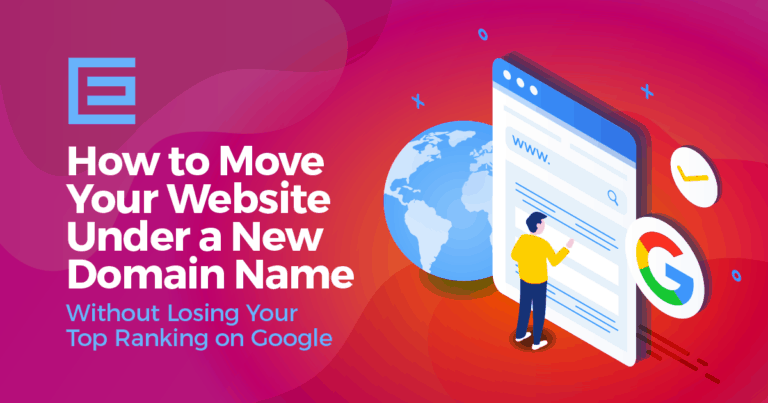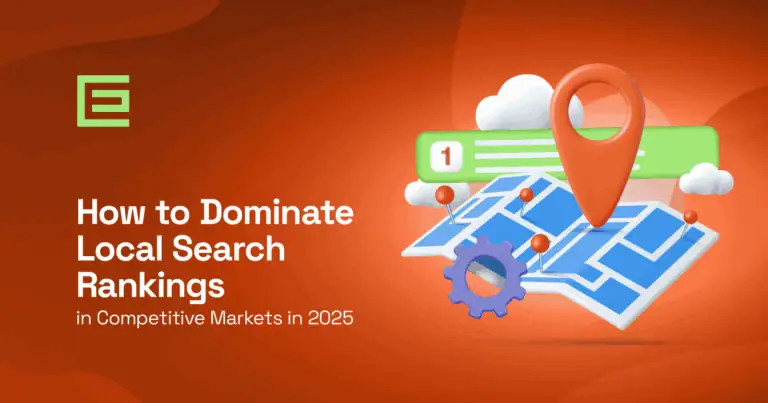Your biggest competitors aren’t just outspending you on ads. They’re leveraging something far more powerful: their customers’ authentic voices to dominate local search results while you’re still writing blog posts that nobody reads. Sound frustrating? Here’s the reality: UGC SEO has become the secret weapon that’s reshaping how local businesses climb to the top of search rankings.
Here’s what’s happening that most small business owners are missing. Twenty-five percent of search results for major brands now come from user-generated content, and that number isn’t slowing down. Meanwhile, Reddit’s organic traffic surged 603% since June 2023, and Quora jumped 379% in the same period. Search engines are prioritizing real human experiences over polished brand content.
- 1Why Search Engines Love User-Generated Content
- 2UGC Content Types That Actually Work for Local SEO
- 3Advanced UGC Collection Strategies That Scale
- 4Measuring UGC SEO Success: Analytics That Matter
- 590-Day Implementation Roadmap
- 6Industry-Specific Quick Wins
- 7Common Mistakes That Kill UGC SEO Results
- 8Ready to transform your local search presence through strategic UGC implementation?
- 9Frequently Asked Questions

In this guide, we’ll explore how UGC SEO efforts can transform your local search visibility through three critical areas:
• The science behind why search engines favor user voices and how to leverage algorithm preferences for maximum local impact
• Proven implementation strategies including schema markup, platform synchronization, and ROI measurement frameworks
• A 90-day action plan that turns UGC from a nice-to-have into a revenue-driving machine
Stop competing on Google’s terms when your customers are ready to do the heavy lifting for you.
Why Search Engines Love User-Generated Content
The Algorithm Shift That Changes Everything
Google’s 2024 Helpful Content System updates explicitly aimed to “elevate forums and user-generated content” in search results. This wasn’t subtle; they literally announced they were prioritizing authentic user voices over traditional SEO content.

But here’s where most business owners get it wrong: they think this means just collecting more five-star reviews. The algorithm actually looks for specific engagement signals that indicate genuine user engagement and value.
Key Performance Indicators Google Tracks:
| Metric | Impact on Rankings | Why It Matters |
|---|---|---|
| Dwell Time | High | Users spend 90% longer on sites with UGC |
| Review Detail | High | Reviews over 75 words rank 23% better |
| Visual Content | Medium | 40%+ photo reviews improve rankings by 26% |
| Response Quality | Medium | Personalized responses boost rankings 19% |
Trust Signals That Actually Move Rankings
Google’s E-A-T framework (Experience, Expertise, Authoritativeness, Trustworthiness) has evolved to prioritize real customer experiences. Here’s how UGC directly impacts your local search performance:
Experience: Real customer stories carry more weight than your marketing copy. When someone writes a detailed review about their experience at your restaurant, describing specific dishes and service quality, that content quality demonstrates actual human interaction with your business.
Trustworthiness: Websites with UGC see a 29% increase in web conversions, plus 20% more return visitors. These engagement metrics directly influence how search engine rankings evaluate your content’s value. Building positive reviews for local business success requires systematic approaches that generate authentic customer feedback consistently.
Local Authority: Review signals account for 16% of Local 3-Pack ranking factors on Google, but location-specific content in reviews provides even stronger geographic relevance signals.
UGC Content That Actually Works for Local SEO
Not all user-generated content carries equal SEO weight. Understanding the hierarchy helps you focus efforts on content that actually moves rankings.
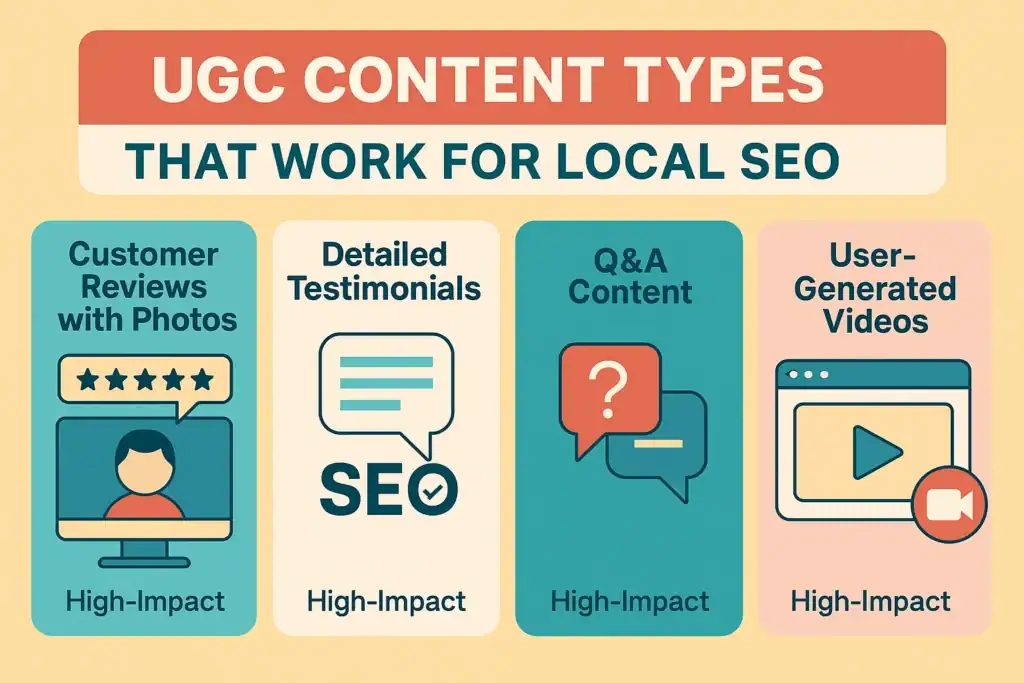
High-Impact UGC (Direct Ranking Benefits)
Customer Reviews with Photos
- Generate fresh content diversity and natural keyword variations
- User-generated videos receive 10x more views than brand-created content
- Photos increase engagement and reduce bounce rates
Detailed Testimonials
- Provide authentic content quality that boosts E-A-T signals
- Can be optimized with schema markup for rich snippets
- Include natural long-tail keyword usage
Q&A Content
- Addresses actual customer concerns and questions
- Creates opportunities for featured snippet appearances
- Demonstrates ongoing customer engagement
Implementation Strategy by Business Type
| Business Type | Most Effective UGC | Collection Method | SEO Benefit |
|---|---|---|---|
| Restaurants | Food photos, atmosphere reviews | Social campaigns, incentives | Local visibility, “near me” searches |
| Professional Services | Case studies, outcome testimonials | Follow-up surveys, referral requests | Trust building, expertise demonstration |
| Retail | Product-in-use photos, styling tips | Contests, user challenges | Product discovery, visual search |
| Home Services | Before/after photos, project stories | Project completion follow-up | Local authority, specific service queries |
Advanced UGC Collection Strategies That Scale
Moving beyond basic review requests, smart businesses create systematic approaches that generate consistent, high-quality user content without appearing pushy or inauthentic.
The Customer Journey Integration Method
Rather than treating UGC collection as an afterthought, integrate it naturally into your customer experience. This systematic approach generates more authentic content because requests feel like genuine interest in customer satisfaction rather than desperate pleas for reviews.
During the pre-service phase, set expectations by mentioning that you’ll follow up to ensure satisfaction. This plants the seed that feedback is important to your business. Create anticipation for the service experience by highlighting what makes your approach unique or noteworthy.
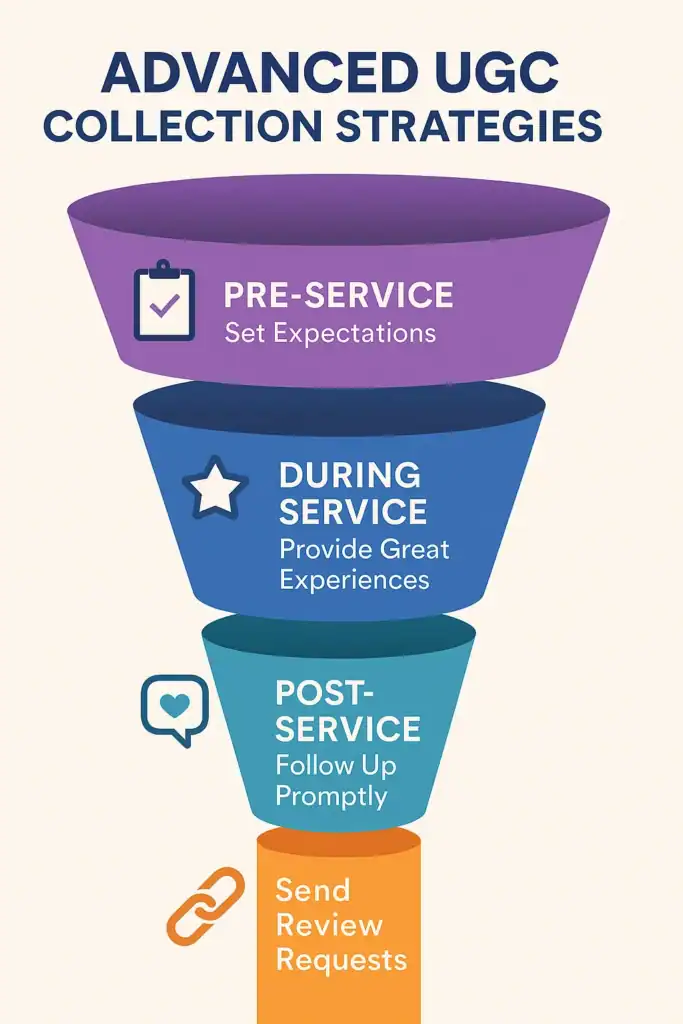
Throughout service delivery, provide exceptional experiences worth sharing while mentioning specific details customers might include in future reviews. Take progress photos (with permission) for before/after documentation that customers can reference in their testimonials.
Post-service follow-up should happen within 24-48 hours while the experience remains fresh. Send personalized thank-you messages that reference specific aspects of their project or visit. Ask targeted questions about their experience rather than generic satisfaction ratings. Provide easy links to preferred review platforms without being pushy about it.
Platform-Specific Collection Tactics
Different platforms require different approaches to maximize UGC generation and SEO efforts impact. Understanding these nuances helps you create content diversity that performs well on each channel while supporting your overall local SEO objectives.
Your Google Business Profile isn’t just a listing; it’s a UGC generation engine. Strategic Q&A management involves monitoring and seeding the Questions section with common inquiries that allow for detailed, keyword-rich responses. Create visually interesting experiences that customers naturally want to photograph and share. Share customer content through GMB posts to increase visibility and engagement. Craft responses that include relevant local keywords while addressing customer feedback authentically.
Social platforms offer unique opportunities for visual and community-driven content. Create branded hashtags that encourage location-specific sharing like #YourBusinessDowntown. Launch creative contests that showcase your products or services in real-world settings. Feature customer experiences through Instagram Stories or Facebook Stories. Create Facebook groups or LinkedIn communities where customers naturally share experiences and ask questions. Learning how to earn positive local reviews and social mentions across these platforms requires understanding each platform’s unique engagement patterns and user expectations.
Website Integration Strategies:
Your website should be the central hub where all UGC comes together effectively. Create comprehensive customer story sections with proper schema markup that help search engines understand and display your testimonials. Include relevant reviews and photos on specific product or service pages where they’ll influence purchase decisions. Turn customer success stories into detailed case study blog posts that demonstrate expertise and results. Feature rotating customer testimonials and recent reviews prominently on your homepage to build immediate credibility. Understanding the broader impact requires recognizing new google maps impact on your local business visibility and customer discovery patterns.
Most articles tell you UGC is important but leave you hanging on the “how.” Here’s the technical framework that actually delivers results.
Schema Markup for UGC
Structured data helps search engine optimization and to understand and display your customer content effectively. Here’s what you need to implement:
Review Schema Example:
{
"@context": "https://schema.org",
"@type": "Review",
"itemReviewed": {
"@type": "LocalBusiness",
"name": "Your Business Name"
},
"reviewRating": {
"@type": "Rating",
"ratingValue": "5"
},
"author": {
"@type": "Person",
"name": "Customer Name"
}
}
Key Implementation Steps:
- Install schema markup on all review-containing pages
- Use aggregate rating schema for overall business ratings
- Implement Q&A schema for FAQ sections derived from customer questions
- Add local business schema with review data integration
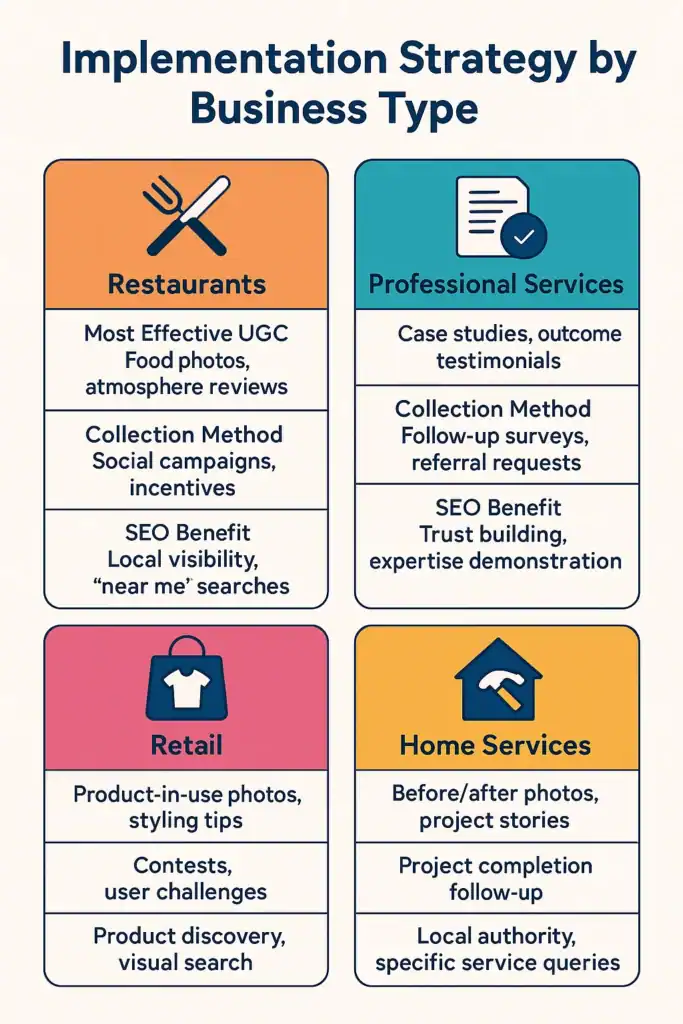
Multi-Platform Synchronization Strategy
Your UGC shouldn’t live in silos. Here’s how to systematically distribute content across platforms:
Platform Priority Matrix:
| Platform | Primary Benefit | Content Type | Update Frequency |
|---|---|---|---|
| Google Business Profile | Local rankings | Reviews, photos, Q&A | Weekly |
| Website | Conversion optimization | Testimonials, case studies | Monthly |
| Social Media | Brand awareness | Visual content, stories | Daily |
| Industry Directories | Niche authority | Professional reviews | Quarterly |
Quality Control System
Raw UGC needs processing before it provides maximum SEO value. Develop filtering based on content that includes specific outcome descriptions, local references and landmarks, detailed experience narratives, and relevant visual elements like photos or videos. The goal isn’t to only showcase perfect reviews, but to prioritize content that provides genuine value to both search engines and potential customers.
Content Curation Workflow:
The collection phase uses multiple touchpoints including email, SMS, and in-person requests to capture feedback when customers are most satisfied. Filter content by scoring based on detail level and local relevance rather than just star ratings. Optimize selected content by adding schema markup and ensuring mobile-friendly display across all platforms. Distribute strategically across appropriate platforms with proper attribution while maintaining authenticity. Monitor performance through engagement metrics and search ranking improvements to refine your approach over time.
Measuring UGC SEO Success: Analytics That Matter
Without proper measurement, UGC SEO becomes expensive guesswork. Here’s how to track performance and prove ROI to justify continued investment.
Essential Tracking Setup
Before launching any UGC initiatives, establish baseline measurements and tracking systems:
Google Analytics Configuration:
- Set up goals for review page visits and form submissions
- Create custom segments for organic local search traffic
- Configure event tracking for UGC interactions (review clicks, photo views)
- Establish conversion funnels that include UGC touchpoints
Many business owners wonder about the effectiveness of local search strategies, asking “will local seo help my website” achieve better results. The answer becomes clear through proper tracking that demonstrates measurable improvements in local visibility and customer engagement.
Search Console Monitoring:
- Track keyword ranking improvements for location-based searches
- Monitor click-through rates from search results to UGC-containing pages
- Identify new keyword opportunities discovered through customer language in reviews
- Watch for featured snippet appearances from FAQ or Q&A content
Platform-Specific Analytics:
- Google Business Profile insights for view and interaction tracking
- Social media analytics for UGC engagement and reach
- Review platform analytics for response rates and customer satisfaction
- Website heatmaps showing UGC engagement patterns
Key Performance Indicators by Business Stage
Startup/New Business Metrics:
- Review acquisition rate (target: 3-5 monthly)
- Average review length (target: 50+ words)
- Local search visibility for business name
- Website traffic from local search queries
Established Business Metrics:
- Local keyword ranking improvements
- Organic traffic growth from location-based searches
- Conversion rate optimization through UGC integration
- Customer lifetime value for UGC-influenced customers
Multi-Location Business Metrics:
- Performance consistency across locations
- Location-specific review generation rates
- Competitive ranking position by market
- Cross-location customer referral patterns
ROI Calculation Framework
Direct Revenue Attribution: Track customers who specifically mention finding your business through reviews or UGC during their conversion process. This requires:
- Customer Survey Integration: Ask new customers how they found you
- Phone Call Tracking: Use different numbers for different UGC campaigns
- UTM Parameter Usage: Track traffic sources from UGC-sharing campaigns
- Conversion Path Analysis: Identify UGC touchpoints in customer journeys
Cost-Benefit Analysis Example:
| Investment Category | Monthly Cost | Annual Cost |
|---|---|---|
| UGC Management Tools | $150 | $1,800 |
| Staff Time (5 hrs/week) | $500 | $6,000 |
| Customer Incentives | $200 | $2,400 |
| Total Investment | $850 | $10,200 |
Revenue Attribution:
| Revenue Source | Monthly Impact | Annual Impact |
|---|---|---|
| Improved Local Rankings | $2,000 | $24,000 |
| Higher Conversion Rates | $1,500 | $18,000 |
| Reduced Marketing Costs | $800 | $9,600 |
| Total Revenue Impact | $4,300 | $51,600 |
Net ROI: 406% annually
Competitive Benchmarking
Monitor your UGC performance against direct competitors to identify opportunities and gauge market position:
Competitor Analysis Metrics:
- Review volume and frequency across platforms
- Average review length and detail level
- Response rates to customer reviews
- Visual content volume (photos/videos in reviews)
- Local search ranking positions for shared keywords
Market Position Assessment: Use tools like BrightLocal, Whitespark, or SEMrush to track share of local search visibility, review platform dominance, customer sentiment compared to competitors, and response quality benchmarks. For businesses considering whether to handle this internally or externally, understanding the benefits of using a local seo company can help determine the most effective approach for your specific situation and resources.
90-Day Implementation Roadmap
Theory without action produces zero results. Here’s your systematic plan to transform UGC from an afterthought into a revenue driver.
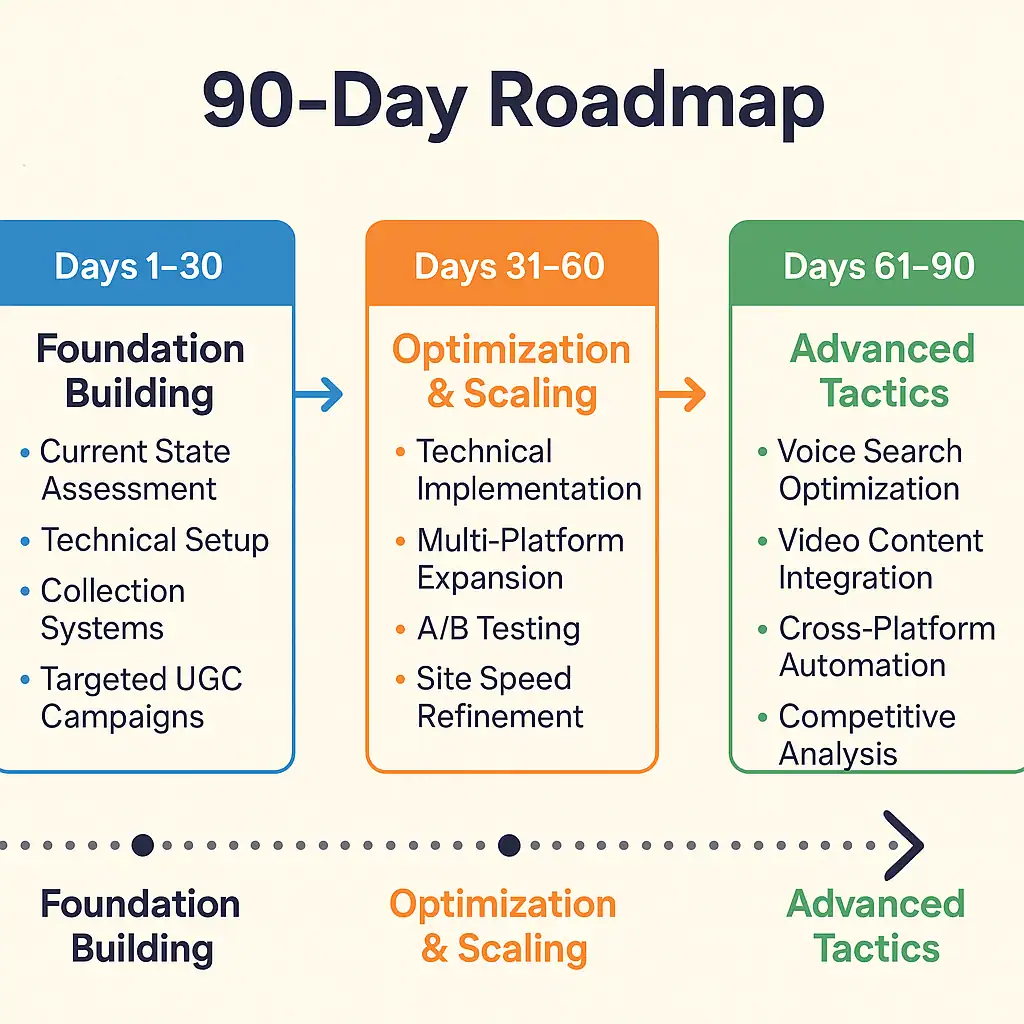
Days 1-30: Foundation Building
Week 1: Current State Assessment
- Audit existing UGC across all platforms
- Analyze competitor review strategies
- Set up tracking systems (Google Analytics, Search Console)
- Document baseline metrics
Week 2: Technical Setup
- Implement schema markup for existing reviews
- Install UGC collection and display tools
- Set up social media monitoring
- Create customer contact databases
Week 3-4: Collection Systems
- Design post-service follow-up sequences
- Create staff training materials
- Develop customer incentive programs
- Begin systematic review collection
Days 31-60: Optimization and Scaling
Month 2 Focus Areas:
- Launch targeted UGC campaigns
- Optimize technical implementation based on performance data
- Expand across multiple platforms
- A/B test different collection approaches
Week 5-6: Campaign Development Create seasonal or event-based campaigns that encourage specific types of UGC:
- Seasonal Campaigns: Holiday shopping experiences, summer service stories, back-to-school preparation
- Event-Based Content: Local festival participation, community involvement, special promotions
- Customer Spotlight Series: Feature detailed customer stories monthly on your website and social media
- Visual Content Challenges: Photo contests, before/after showcases, product styling competitions
Week 7-8: Technical Optimization Based on first month data, refine your technical implementation:
- Site Speed Optimization: Ensure UGC-heavy pages load quickly on mobile devices
- Schema Refinement: Test rich snippet appearances and adjust markup accordingly
- Platform Integration: Streamline content flow between collection points and display locations
- Analytics Enhancement: Set up conversion tracking for UGC-influenced customer journeys
Days 61-90: Advanced Tactics and Scaling
Final Month Objectives:
- Advanced schema implementation and rich snippet optimization
- Competitive differentiation through unique UGC approaches
- Long-term sustainability systems development
- Comprehensive performance analysis and strategy refinement
Week 9-10: Advanced Implementation
- Voice Search Optimization: Ensure UGC content answers common voice search queries about your business
- Video Content Integration: Launch video testimonial collection for enhanced engagement metrics
- Cross-Platform Automation: Set up systems that automatically distribute UGC across multiple channels
- Competitive Analysis: Research competitor UGC strategies and identify differentiation opportunities
Week 11-12: Sustainability Systems
- Staff Training Programs: Ensure all team members understand UGC importance and collection techniques
- Customer Loyalty Integration: Build UGC requests into loyalty programs and repeat customer touchpoints
- Quality Assurance Processes: Establish ongoing content review and optimization procedures
- Performance Documentation: Create reports showing UGC impact on business metrics and search performance
Success Metrics to Achieve by Day 90:
- 5-10 detailed reviews monthly per location (depending on business size)
- 25%+ improvement in local search rankings for primary keywords
- 30%+ increase in organic search traffic from local queries
- 20%+ improvement in conversion rates from organic search visitors
- 15+ pieces of visual UGC (photos/videos) generated monthly
Industry-Specific Quick Wins
Different businesses need different approaches. Here are proven strategies by industry:
Restaurants & Food Service
Quick Win Strategy: Create Instagram-worthy presentation that encourages customer photography
- Collection Method: Table tents with QR codes linking to review requests
- Content Focus: Food photos, atmosphere descriptions, service experiences
- Expected Results: 30-40% increase in visual UGC within 60 days
Professional Services
Quick Win Strategy: Systematic client success story documentation
- Collection Method: Post-project satisfaction surveys with testimonial requests
- Content Focus: Specific outcomes, problem-solving approaches, communication quality
- Expected Results: 2-3 detailed case studies monthly
Retail & E-commerce
Quick Win Strategy: Product-in-use photo campaigns
- Collection Method: Social media contests and styling challenges
- Content Focus: Products in real environments, customer creativity
- Expected Results: 50+ user photos monthly, 20% engagement increase
Common Mistakes That Kill UGC SEO Results
Avoid these costly errors that most businesses make:
1. Generic Review Requests
- Wrong: “Please leave us a review!”
- Right: “Could you share details about your experience with our downtown location’s customer service?”
2. Ignoring Negative Reviews
- Wrong: No response or defensive reactions
- Right: Professional, detailed responses that address specific concerns
3. Platform Silos
- Wrong: Reviews only on Google Business Profile
- Right: Systematic distribution across website, social media, and directories
4. No Quality Control
- Wrong: Accepting any UGC regardless of value
- Right: Curating content that includes local references and specific details
Ready to transform your local search presence through strategic UGC implementation?
Start with the 90-day roadmap above, focusing on systematic review collection and technical optimization before expanding to advanced strategies. Remember: authentic customer voices carry more SEO weight than any marketing content you could create yourself.
Frequently Asked Questions
Most businesses notice initial improvements within 30-45 days, with significant ranking changes typically occurring within 90 days. Timeline depends on current review volume and competitive landscape.
Request detailed feedback within 24-48 hours after service completion when satisfaction is highest. Avoid overwhelming customers with multiple platform requests simultaneously.
Yes, as long as you request honest feedback rather than specifically positive reviews. Acceptable approaches include loyalty points for any review submission or service discounts for detailed testimonials.
Professional, detailed responses to negative reviews actually improve rankings by demonstrating authentic engagement. Address specific concerns, provide solutions, and include relevant keywords naturally.
Reviews with photos and detailed descriptions provide the strongest impact. Content mentioning local landmarks, specific services, and customer outcomes performs better than generic ratings.
Ready to Take the First Step?
Learn how TheeDigital can help with your Web Design and Digital Marketing needs.
Tags: Digital Marketing • Google • Search Engine Optimization

